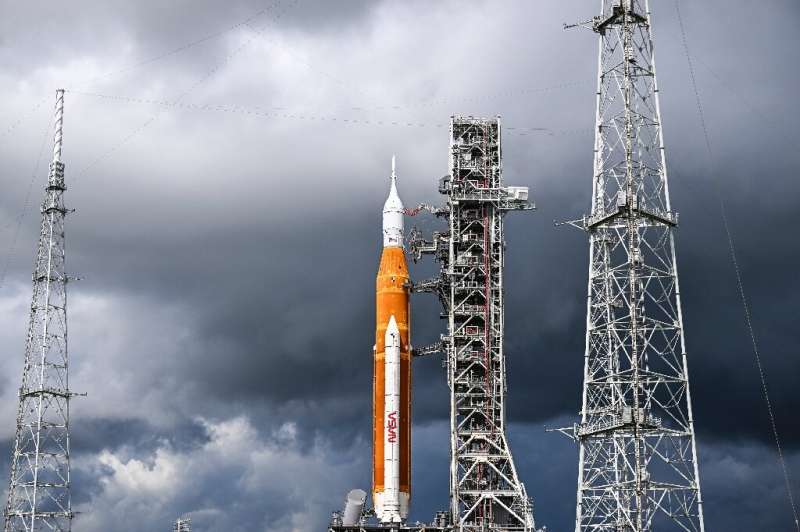NASA eyes two more dates in September for possible Moon launch
Thursday, 08 September 2022 14:47
NASA is looking at September 23 and September 27 as possible dates for its next attempt at launching its Artemis 1 mission to the Moon, senior official Jim Free told reporters Thursday.
Two previous attempts were scrapped after the giant Space Launch System rocket experienced technical glitches including a fuel leak.
"The 23rd is a 6:47am window open for 80 minutes, and the 27th is an 11:37am window with a 70-minute duration," said Free, associate administrator for the agency's exploration systems development directorate.
Spiralling stars provide a window into the early Universe
Thursday, 08 September 2022 13:00 Image:
Image:
Astronomers have been bemused to find young stars spiralling into the centre of a massive cluster of stars in the Small Magellanic Cloud, a satellite galaxy of the Milky Way. The outer arm of the spiral in this huge, oddly shaped stellar nursery – called NGC 346 – may be feeding star formation in a river-like motion of gas and stars. This is an efficient way to fuel star birth, researchers say.
The Small Magellanic Cloud has a simpler chemical composition than the Milky Way, making it similar to the galaxies found in the younger Universe, when heavier elements were more scarce.
Beyond Gravity: Key supplier for constellations
Thursday, 08 September 2022 12:45
Beyond Gravity (formerly RUAG Space) is a key supplier to satellite constellations. New Space and commercial customers trust in Beyond Gravity for the deployment of satellites into space as well as for controlling, positioning and thermal protection of satellites in orbit.
Apple to be largest user of Globalstar’s satellite network for iPhone messaging
Thursday, 08 September 2022 12:18
Apple formally announced its long-anticipated partnership with Globalstar Sept. 7 to provide satellite messaging services for new iPhones and becoming Globalstar’s biggest customer.
The post Apple to be largest user of Globalstar’s satellite network for iPhone messaging appeared first on SpaceNews.
DART sets sights on asteroid target
Thursday, 08 September 2022 11:54 NASA's Double Asteroid Redirection Test (DART) spacecraft recently got its first look at Didymos, the double-asteroid system that includes its target, Dimorphos. On Sept. 26, DART will intentionally crash into Dimorphos, the asteroid moonlet of Didymos. While the asteroid poses no threat to Earth, this is the world's first test of the kinetic impact technique, using a spacecraft to deflect an as
NASA's Double Asteroid Redirection Test (DART) spacecraft recently got its first look at Didymos, the double-asteroid system that includes its target, Dimorphos. On Sept. 26, DART will intentionally crash into Dimorphos, the asteroid moonlet of Didymos. While the asteroid poses no threat to Earth, this is the world's first test of the kinetic impact technique, using a spacecraft to deflect an as Albedo raises $48M to capture the highest resolution satellite imagery
Thursday, 08 September 2022 11:54 Albedo, a company developing low-flying satellites that will deliver ultra high resolution images, has announced a $48M Series A financing round co-led by Breakthrough Energy Ventures and Shield Capital, bringing the company's total funding to $58M in less than two years since inception.
Participation in the round included new investors Republic Capital, Giant Step Capital, and C16 Venture
Albedo, a company developing low-flying satellites that will deliver ultra high resolution images, has announced a $48M Series A financing round co-led by Breakthrough Energy Ventures and Shield Capital, bringing the company's total funding to $58M in less than two years since inception.
Participation in the round included new investors Republic Capital, Giant Step Capital, and C16 Venture UK built Prometheus 2 imaging and monitoring cubesats on track for UK launch
Thursday, 08 September 2022 11:54 The Prometheus 2 satellites, which have been jointly designed by Airbus and In-Space Missions, are on track for their UK launch from Newquay, Cornwall, later this year with environmental testing complete and vibration testing ongoing.
The Prometheus 2 cubesats are owned by the Defence Science and Technology Laboratory (Dstl) on behalf of the Ministry of Defence (MOD). They have been co-fun
The Prometheus 2 satellites, which have been jointly designed by Airbus and In-Space Missions, are on track for their UK launch from Newquay, Cornwall, later this year with environmental testing complete and vibration testing ongoing.
The Prometheus 2 cubesats are owned by the Defence Science and Technology Laboratory (Dstl) on behalf of the Ministry of Defence (MOD). They have been co-fun Surrey Satellite opens new Australian office
Thursday, 08 September 2022 11:54 SSTL has announced that on the 13th September it will open an office in Australia in Adelaide. The announcement follows the meeting on Friday 2nd September between the Rt. Hon Anne-Marie Trevelyan MP (UK Secretary of State for Trade) and Senator The Hon Don Farrell (Australian Minister For Trade and Tourism) during which they discussed ways of strengthening the United Kingdom - Australia economi
SSTL has announced that on the 13th September it will open an office in Australia in Adelaide. The announcement follows the meeting on Friday 2nd September between the Rt. Hon Anne-Marie Trevelyan MP (UK Secretary of State for Trade) and Senator The Hon Don Farrell (Australian Minister For Trade and Tourism) during which they discussed ways of strengthening the United Kingdom - Australia economi Sidus Space executes multiple launch agreement with SpaceX
Thursday, 08 September 2022 11:54 Sidus Space, Inc. (NASDAQ:SIDU), a Space-as-a-Service satellite company focused on mission critical hardware manufacturing; multi-disciplinary engineering services; satellite design, production, launch planning, mission operations; and in-orbit support, has announced that it has signed a launch agreement with SpaceX for five launches, beginning in early 2023.
Sidus Space has designed and i
Sidus Space, Inc. (NASDAQ:SIDU), a Space-as-a-Service satellite company focused on mission critical hardware manufacturing; multi-disciplinary engineering services; satellite design, production, launch planning, mission operations; and in-orbit support, has announced that it has signed a launch agreement with SpaceX for five launches, beginning in early 2023.
Sidus Space has designed and i Europe's tallest ever communications satellite launched
Thursday, 08 September 2022 11:54 The fourth Spacebus Neo satellite to benefit from ESA's Neosat programme has launched into space on board the second Ariane 5 launch mission of 2022. The 8.9 metre, three-storeys-high communications satellite - which will deliver high-speed broadband and in-flight connectivity across Europe for its operator, Eutelsat - weighs 6.525 tonnes and accounted for 99% of the 6.62-tonne launch mass.
The fourth Spacebus Neo satellite to benefit from ESA's Neosat programme has launched into space on board the second Ariane 5 launch mission of 2022. The 8.9 metre, three-storeys-high communications satellite - which will deliver high-speed broadband and in-flight connectivity across Europe for its operator, Eutelsat - weighs 6.525 tonnes and accounted for 99% of the 6.62-tonne launch mass. Scotland's space sector set to become greenest on Earth
Thursday, 08 September 2022 11:54 Scotland's space sector has declared its commitment to reducing its impact on the environment through the publication of a new sustainable space roadmap, the first of its kind on Earth.
The new roadmap sets out the steps needed to achieve the long-term goals of Scottish space missions, which are to be space debris neutral, zero emissions created from on-the-ground activities, and for Scotl
Scotland's space sector has declared its commitment to reducing its impact on the environment through the publication of a new sustainable space roadmap, the first of its kind on Earth.
The new roadmap sets out the steps needed to achieve the long-term goals of Scottish space missions, which are to be space debris neutral, zero emissions created from on-the-ground activities, and for Scotl Ariane 5 launches EUTELSAT KONNECT VHTS satellite
Thursday, 08 September 2022 11:54 On Wednesday, September 7th, 2022 at 6:45 pm local time, an Ariane 5 launcher, operated by Arianespace, successfully lifted off from Europe's Spaceport in Kourou, French Guiana (South America), carrying the EUTELSAT KONNECT VHTS telecommunications satellite.
"With yet another successful launch, Arianespace is proud to have placed in orbit, for the 37th time since 1983, a satellite for the
On Wednesday, September 7th, 2022 at 6:45 pm local time, an Ariane 5 launcher, operated by Arianespace, successfully lifted off from Europe's Spaceport in Kourou, French Guiana (South America), carrying the EUTELSAT KONNECT VHTS telecommunications satellite.
"With yet another successful launch, Arianespace is proud to have placed in orbit, for the 37th time since 1983, a satellite for the Space launch from Australia to use satellite tracking from Inmarsat
Thursday, 08 September 2022 11:54 Inmarsat, the world leader in global, mobile satellite communications has signed an agreement with Gilmour Space Technologies to support space launches from Australia using Inmarsat's InRange system. Gilmour Space is Australia's leading launch services company that is developing orbital-class launch vehicles and satellite platforms.
InRange from Inmarsat provides rapid, responsive and cost
Inmarsat, the world leader in global, mobile satellite communications has signed an agreement with Gilmour Space Technologies to support space launches from Australia using Inmarsat's InRange system. Gilmour Space is Australia's leading launch services company that is developing orbital-class launch vehicles and satellite platforms.
InRange from Inmarsat provides rapid, responsive and cost Glaciers flowed on ancient Mars, but slowly
Thursday, 08 September 2022 11:54 The weight and grinding movement of glaciers has carved distinctive valleys and fjords into Earth's surface. Because Mars lacks similar landscapes, researchers believed ancient ice masses on the Red Planet must have been frozen firmly to the ground. New research suggests they were not stuck in place, but just moved very slowly.
Motion is part of the definition of a glacier. On Earth, meltw
The weight and grinding movement of glaciers has carved distinctive valleys and fjords into Earth's surface. Because Mars lacks similar landscapes, researchers believed ancient ice masses on the Red Planet must have been frozen firmly to the ground. New research suggests they were not stuck in place, but just moved very slowly.
Motion is part of the definition of a glacier. On Earth, meltw NASA taps Axiom Space for first Artemis lunar spacesuits
Thursday, 08 September 2022 11:54 NASA has selected Axiom Space to deliver a moonwalking system for the Artemis III mission, which will land Americans on the surface of the Moon for the first time in over 50 years. This award - the first one under a competitive spacesuits contract - is for a task order to develop a next generation Artemis spacesuit and supporting systems, and to demonstrate their use on the lunar surface during
NASA has selected Axiom Space to deliver a moonwalking system for the Artemis III mission, which will land Americans on the surface of the Moon for the first time in over 50 years. This award - the first one under a competitive spacesuits contract - is for a task order to develop a next generation Artemis spacesuit and supporting systems, and to demonstrate their use on the lunar surface during 